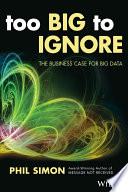

In the modern business landscape, data has become one of the most valuable assets. 'Too Big to Ignore' emphasizes that organizations must not only collect data but also learn how to analyze and leverage it effectively. The book outlines various methodologies for data collection, including qualitative and quantitative approaches, and stresses the importance of having a data-driven culture. It argues that businesses that ignore data are at a significant disadvantage, as they miss out on insights that can inform decision-making, optimize operations, and enhance customer experiences. The book also discusses the ethical considerations surrounding data usage, including privacy concerns and the importance of transparency.
Continue readingThe book advocates for a paradigm shift in how decisions are made within organizations. It posits that traditional decision-making processes, often based on intuition or past experiences, are no longer sufficient in an age where data is abundant. It presents case studies showing how companies that embrace data-driven decision-making can outperform their competitors. The author provides a framework for implementing data-driven strategies, emphasizing the need for training employees in data literacy and fostering an environment where data is readily accessible and utilized in everyday operations.
Continue readingTechnology plays a crucial role in the management and analysis of data. The book explores various tools and platforms that facilitate data collection, storage, and analysis. It discusses cloud computing, machine learning, and artificial intelligence as transformative technologies that can enhance an organization's ability to process vast amounts of data quickly and efficiently. The author highlights the importance of choosing the right technology stack that aligns with an organization's goals and the need for continuous investment in technology to stay competitive.
Continue readingFor organizations to truly leverage data, a cultural shift is necessary. The book discusses how leadership must champion data initiatives and encourage a culture of experimentation and learning. It emphasizes the importance of collaboration across departments, as data insights often require a multi-faceted approach to interpretation. The author provides strategies for overcoming resistance to change, including communicating the benefits of data utilization and providing incentives for teams to engage with data more actively.
Continue readingWhile big data offers immense opportunities, it also presents challenges and risks that organizations must navigate. The book outlines potential pitfalls such as data quality issues, the risk of over-reliance on data, and the ethical implications of data usage. The author stresses the importance of establishing robust data governance frameworks to ensure data integrity and compliance with regulations. Additionally, it discusses how to balance quantitative data with qualitative insights to avoid making decisions based solely on numbers.
Continue readingThe book concludes with a forward-looking perspective on emerging trends in data and technology. It discusses the rise of predictive analytics, the Internet of Things (IoT), and the increasing importance of real-time data processing. The author encourages readers to stay informed about technological advancements and to be proactive in adapting their strategies to incorporate these trends. This section serves as a call to action for organizations to innovate and remain agile in a rapidly changing landscape.
Continue readingThroughout the book, the author includes various case studies that illustrate the successful application of data-driven strategies across different industries. These real-world examples serve to reinforce the concepts discussed and provide readers with tangible evidence of the benefits of embracing big data. The author analyzes both successes and failures, providing valuable lessons that organizations can learn from. This practical approach helps to bridge the gap between theory and practice, making the insights more relatable and actionable.
Continue reading